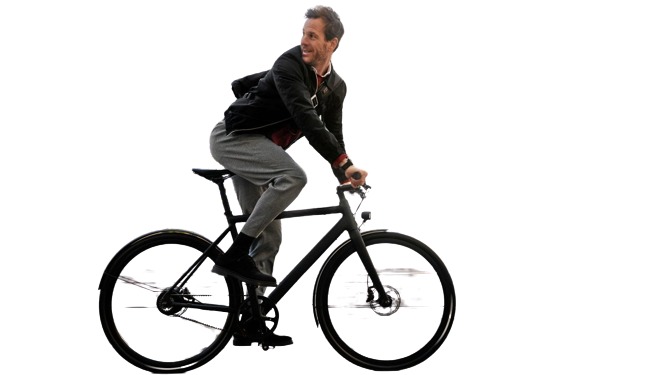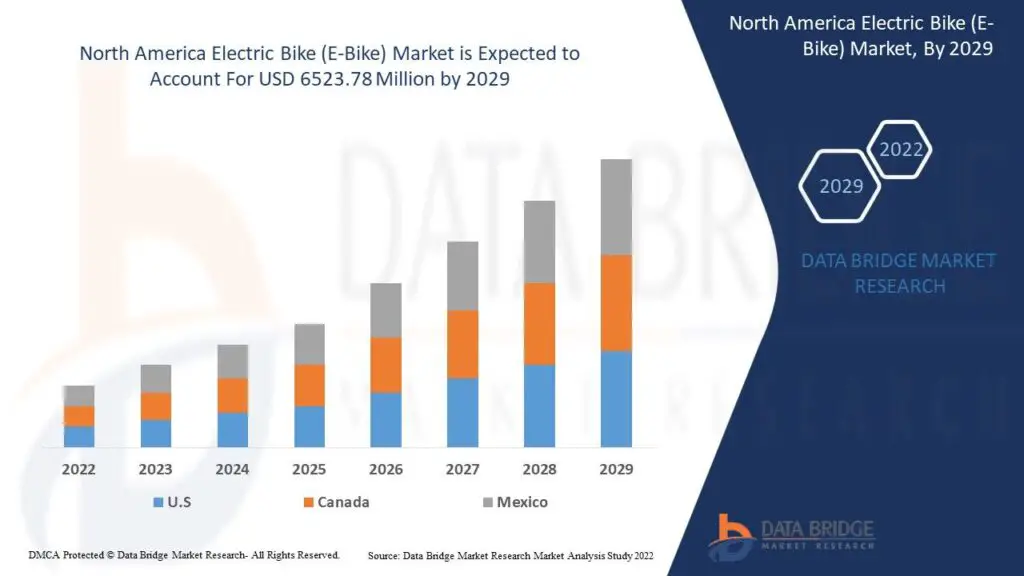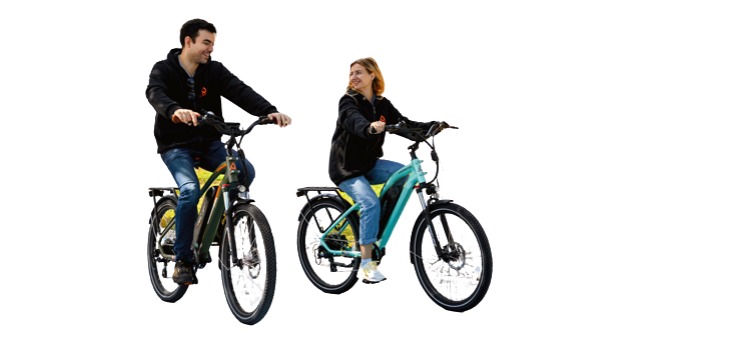Electric bikes are becoming more popular and affordable, but how fast does an electric bike go? If you are thinking of buying an e-bike, you might be wondering what factors affect its speed and performance.
In this blog post, we will explore the different types of electric bikes, their speed range, and the laws and regulations that govern their use. We will also give you some tips on how to increase your electric bike’s speed and enjoy a smooth and exhilarating ride.
- Also Read: Best Class 1 E-Bikes
- Also Read: Best Class 2 E-Bikes
- Also Read: Best Class 3 E-Bikes
- Also Read: Best Featherweight E-Bikes
Electric Bike Speed
Electric bikes are bicycles that have an electric motor and a battery that provide assistance to the rider. The speed of an electric bike depends on several factors, such as the class of the bike, the power of the motor, the capacity of the battery, the terrain, the tire size, and the rider’s input.
The higher the wattage of the motor and the capacity of the battery, the faster and longer the electric bike can go. However, the speed of an electric bike can also be affected by the road conditions, the wind, the weight of the rider, and the size of the tires.
Therefore, the top speed of an electric bike can vary depending on the situation and the settings of the bike.

How Fast Do Electric Bikes Go?
Most electric bikes are subject to legal speed limits that vary by country and region. These speed limits determine how fast the motor can assist the rider, not how fast the rider can pedal without assistance.
The most common speed limit for electric bikes is 15.5 mph (25 km/h), which applies in the UK, Europe, and Australia. In the US, there are different classes of electric bikes, with different speed limits. Class 1 and class 2 electric bikes are limited to 20 mph (32 km/h), while class 3 electric bikes can go up to 28 mph (45 km/h).
Some electric bikes can go faster than these limits, but they are usually treated as mopeds and require registration, insurance, and a helmet.
Therefore, the answer to how fast electric bikes can go is not straightforward, as it depends on the type of electric bike, the local laws, and the rider’s own effort.
Electric Bike Motor Power
Electric bike motor power is the measure of how much energy the motor can deliver to assist the rider’s pedaling. The power of an electric bike motor is usually expressed in watts (W), which is the product of voltage (V) and current (A). The higher the wattage, the more powerful the motor and the faster the electric bike can go.
The most common legal limit for electric bike motor power is 250W, which applies in the UK, Europe, and Australia. This means that the motor can only assist the rider up to a speed of 15.5 mph (25 km/h), after which it will cut off.
Some electric bikes have higher wattage motors, such as 500W or 750W, which can provide more torque and speed. But they may require registration, insurance, and a helmet, depending on the local laws.
In the US, there are different classes of electric bikes with different speed limits, ranging from 20 mph (32 km/h) to 28 mph (45 km/h).
The power of an electric bike motor is not the only factor that determines how fast and far an electric bike can go. It is rather a component that works in conjunction with other factors.
The battery capacity, the level of assistance, the rider’s weight, the terrain, and the wind are also important variables that affect the range and speed of an electric bike.
The Growth of the Electric Bike Industry
The growth of the e-bike industry is a phenomenon that reflects the changing preferences and needs of consumers in the transportation sector. E-bikes are making cycling easier, faster, and more enjoyable.

Electric bikes have many advantages over conventional bicycles and cars, such as being eco-friendly, cost-effective, health-promoting, and space-saving. E-bikes are also suitable for various purposes and applications, such as city commuting, mountain trekking, and cargo delivery.
The e-bike market is expected to experience rapid global growth in the coming years. It is driven by factors such as increased awareness about fitness, rising environmental concerns, reduced traffic congestion, and government initiatives to promote cycling.
However, the e-bike industry is also facing some challenges and opportunities. They include the emergence of new technologies and innovations, the competition from other modes of transportation, and the variation of legal regulations across different regions.
The e-bike industry is adapting to these changing market conditions and consumer demands. Many manufacturers offer more diverse, affordable, and high-quality electric bikes to the potential and existing customers.
The e-bike industry is becoming the fastest growing industry in the transportation sector, and has a bright future ahead.
Different Types of Electric Bikes and Their Speed Range
How fast you can go on an e-bike depends on what class of e-bike you have. Here is a quick guide to the different classes of electric bikes and their speed limits:
Class 1 Electric Bikes
It is a pedal assist electric bike. If you want a simple and easy way to boost your pedaling power, a class 1 e-bike is for you. These e-bikes have a top speed of 20 mph and only provide electric assistance when you are pedaling.
Some of them may have a button to give you a burst of speed, but only when you are already pedaling. Class 1 electric bikes are ideal for beginners who want to enjoy the benefits of an e-bike without going too fast.
Class 2 Electric Bikes
It is a throttle e-bike. If you want more control over your electric power, a class 2 electric bike might suit you better. These e-bikes also have a top speed of 20 mph, but they let you use the electric motor without pedaling.
You can either pedal and get electric assistance, or use the throttle and cruise along without pedaling. Class 2 electric bikes are perfect for riders who want the convenience of a throttle, especially when starting from a stop or climbing a hill.
Class 3 Electric Bikes
It is a speed electric bike. If you want to go faster and farther on your e-bike, a class 3 e-bike is what you are looking for. These e-bikes have a top speed of 28 mph and provide electric assistance only when you are pedaling.
Some class 3 electric bikes may have a throttle, but it won’t work above 20 mph. These e-bikes are good for experienced riders who want to ride their e-bike on busier roads and keep up with traffic.
However, be aware that class 3 e-bikes have more restrictions on where you can ride them, depending on your state’s laws.
Factors That Affect Electric Bike Speed
Following are the factors that determine how fast does an electric bike go:
Motor Type and Power
The motor power is measured in watts, and it determines how fast the electric bike can accelerate, i.e., how quickly it can reach a certain speed. The top speed is limited by the motor controller, which is set according to the class (1, 2 or 3) of the electric bike.
For example, a 250-watt motor and a 750-watt motor can both achieve the same top speed, but the 750-watt motor will get there faster. The location of the motor (rear hub or mid-drive) also does not affect the speed potential of the electric bike.
Battery Capacity
The battery capacity influences how far the electric bike can travel on a single charge, rather than how fast it can go. The battery capacity is measured in watt-hours, which indicates how many watts of power the battery can provide for one hour. The larger the battery, the more watt-hours it has, and the longer the riding range.
Terrain and Road Conditions
The terrain and road conditions affect the amount of power required from the electric bike to maintain a certain speed. For example, going uphill requires more power than going on a flat road.
Therefore, the electric bike will use more battery power when climbing steep hills, which will reduce the riding range. The same applies to rough or uneven surfaces, which create more friction and resistance for the bike.
Rider Weight and Skill Level
The rider weight and skill level also have an impact on the electric bike speed and battery consumption. The heavier the rider, the more work the motor has to do to assist the pedaling, and the more battery power is used.
The skill level of the rider affects how efficiently they use the bike’s gears, which can optimize the performance of the motor and the battery. A skilled rider knows how to shift to lower gears when approaching a hill, which makes it easier to pedal and reduces the strain on the motor.
Riding Mode
Most electric bikes have different power modes, which can be selected by a button on the handlebar. The power modes determine how much assistance the motor provides to the rider. The higher the power mode, the faster and easier the ride, but the more battery power is consumed.
Therefore, if the rider wants to maximize the speed and minimize the effort, they can choose the highest power mode, but they will also get the shortest riding range.
How Does Electrical Assistance Work?
You get two kinds of power boost on an electric bike: pedal assist and throttle. Pedal assist gives you a gentle push from the motor as you pedal, while throttle works like a motorcycle. The objective of pedal assist is to provide you with a smooth and natural ride.
Which Level Should You Choose?
With pedal assist, you can choose how much power you want from the electric motor. The lowest setting lets you pedal mostly on your own, which is great for flat roads or when you feel like a challenge.
The highest setting gives you a lot of help, which is handy for hills or when you want to go fast and easy. And of course, you can switch between settings as you ride.
However, the more you use the motor, the faster the battery drains. And the battery also depends on how heavy you are and how rough the terrain is. So don’t forget to keep an eye on the battery level.
And don’t worry, even if the battery dies, you can still pedal your way home and charge it later.

Your Ideal E-Bike’s Speed Depends on You and Your Needs
There is no one-size-fits-all answer to the question of how fast an e-bike can go. Different e-bikes have different speed capabilities, depending on their motor type, battery size, and class. But more importantly, different riders have different speed needs, and that depends on how and why they use their e-bikes.
Some cyclists need a fast e-bike that can help them commute to work, avoid traffic, and save time. Others prefer a comfortable e-bike that can let them enjoy a leisurely ride, explore their surroundings, and have fun. And some want a cargo e-bike that can carry their stuff, their kids, or anything else, without compromising on speed or smoothness.
That’s why there is a range of e-bikes that can suit your speed needs, whatever they are. Whether you want to go up to 28 mph, 20 mph, or somewhere in between, there is an electric bike for you.
Legal Limitations on Electric Bike Speeds
According to the federal law (15 U.S.C. § 2085), an electric bike is also known as a ‘low-speed electric bicycle’. It has two or three wheels, pedals that work, and an electric motor that is less than 750 watts (1 h.p.). It can go up to 20 mph on a flat and smooth surface, but only if the rider weighs 170 pounds and does not pedal at all.
This law sets a limit for how fast an electric bike can go with just the motor, but it does not say anything about how fast it can go with both the motor and the pedals. Different states have different rules for the maximum speed of each type of electric bike. There are also speed limits for the roads and trails where electric bikes can ride.
Usually, only class 1 electric bikes (no throttle, 20 mph max speed) are allowed on off-road trails (if they are allowed at all). Some city bike paths also only allow class 1 electric bikes. class 3 electric bikes (28 mph max speed with the motor) can usually ride on city streets, but it is always a good idea to check the local laws before riding.
Regulations in the United States
Different agencies have different rules for e-bikes on public lands in the US. You can tell them apart by their initials. Usually, only Class 1 e-bikes (no throttle, 20 mph max speed) can ride on trails off road, if they are allowed at all.
For bike paths or city streets, you have to check the laws where you live and ride. Some places only allow class 1 e-bikes on bike paths. It is always a good idea to find out what the local land manager says about e-bikes.
Consequences of Violating Speed Limits
If you go faster than the speed limit on an e-bike, you can get a ticket just like a car driver. Changing the speed of an e-bike (by adding something to the motor or changing the settings) is usually not allowed.
This is because the e-bike will not be an e-bike anymore. It will be a motor vehicle that needs to follow the rules for registration, licensing, insurance and equipment.
How Do Electric Bikes’ Speed Ratings Affect Performance?
The speed rating of class 1 or class 3 does not make a big difference in how the e-bike performs, for most people. The only time it might matter is if you want to ride fast in the city, where a class 3 electric bike can help you match the speed of the cars. This might make you more visible to the drivers.
Tips for Maximizing Electric Bike Speed
E-bikes are still bicycles, so you need to follow the same rules to get the best out of them. Here are some tips to maximize electric bike speed:
Power Mode
Your electric bike lets you choose how much power you want to use when you ride. The more power you use, the easier it is to pedal and go fast. But be careful, using more power also means using more battery. If you want to ride longer with the motor helping you, use less power.
Battery
Don’t let your electric bike battery pack run out of juice—charging it fully can take a long time, so plan ahead. If you want to ride your e-bike tomorrow, plug in your battery to the charger that came with your e-bike today.
Maintenance
To keep your electric bike running smoothly, you need to take care of your chain and tires. Make sure your chain is well-lubed and free of any black sludge that can damage it.
Check your tires regularly for air pressure and fill them up as needed. You can find the recommended pressure on the side of your tires. An e-bike tire pressure gauge is a must-have accessory, along with an e-bike lock and helmet.
Gears
Don’t make the common mistake of using the highest power mode on your electric bike every time you face a hill. Instead, use your gears wisely and shift to the lower ones when you climb. Then, if you need some extra help, you can switch to the higher power modes on your motor.
This way, you will protect your knees and your bike’s parts from too much stress. Remember, your electric bike has many gears for a reason, so use them as you would on a regular bike.
Conclusion
The electric bike speed is not as important as some people think. The speed limits can affect where you can ride your e-bike, but other factors matter more for your daily use. You should look for an electric bike that is reliable, easy to use, and has a long battery life.
These things make an e-bike great, and not just the price. You should choose an electric bike with a motor and lithium-ion battery pack system from well-known and trusted e-bike brands, such as Shimano or Bosch. This is the best way to be happy with your e-bike.
Frequently Asked Questions (FAQs)
What is the top speed of electric Bikes?
The class of electric bike you choose determines when the motor stops helping you. You can pedal faster than 20 mph on a class 1 bike, but the motor won’t assist you beyond that speed. For Class 3 bikes, however, the motor will keep supporting you until you reach 28 mph.
Can electric Bikes go 30 mph?
Only class 3 e-bikes can go faster than 20 mph with just the motor power. According to federal vehicle law (NHTSA regulations), any device that can do that is a kind of ‘motor vehicle.’ Depending on the state law definitions, such a vehicle may be classified as a ‘motorized bicycle,’ a moped or a motorcycle, and will have different regulations.
How fast will a 500W electric bike go?
Several factors can affect how fast a 500W electric bike can go, such as how much the rider weighs, the type of terrain, the size of the wheels, and how much the rider pedals. With pedal assistance, a 500W electric bike can go as fast as 20-28 miles per hour. Read more